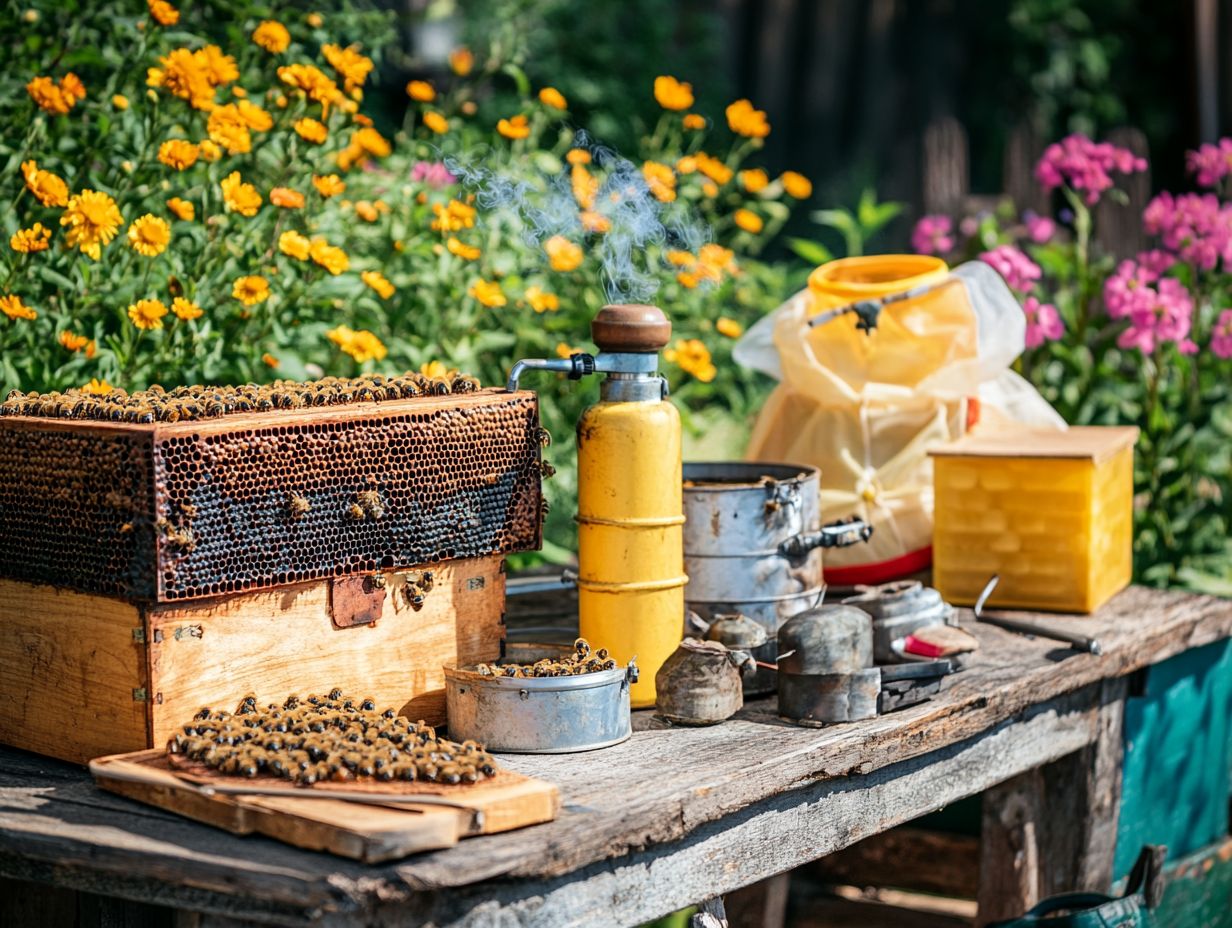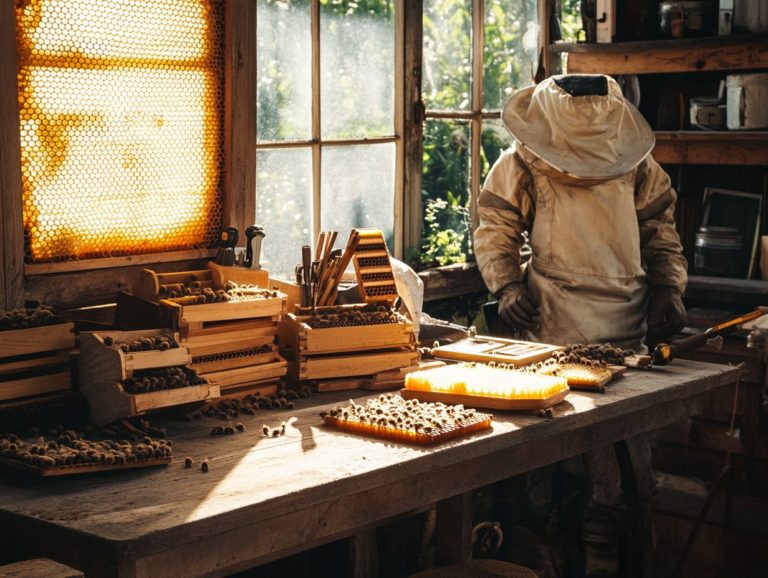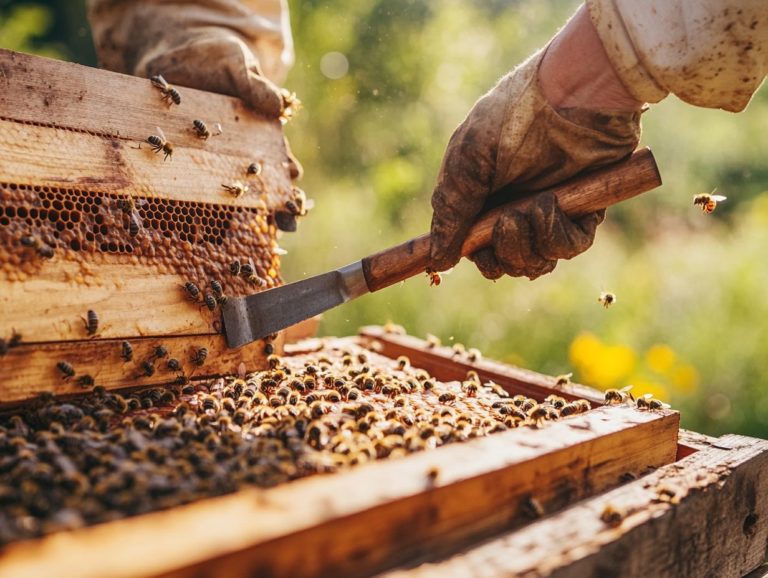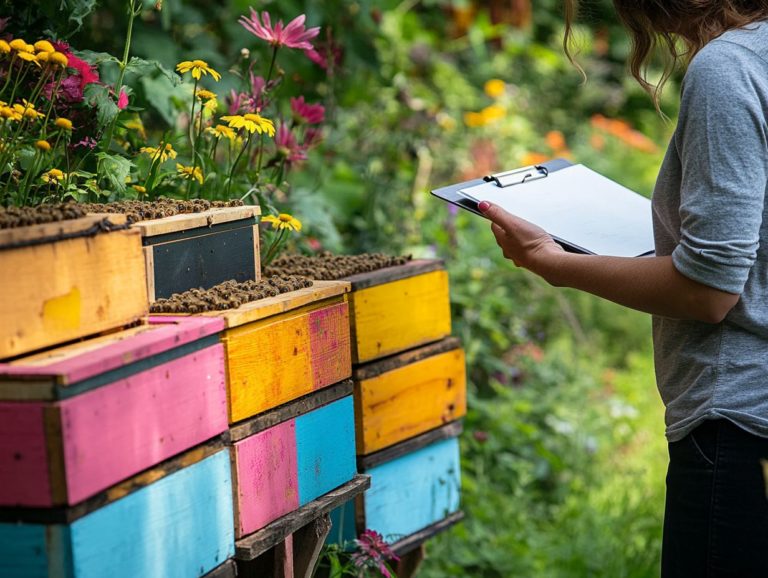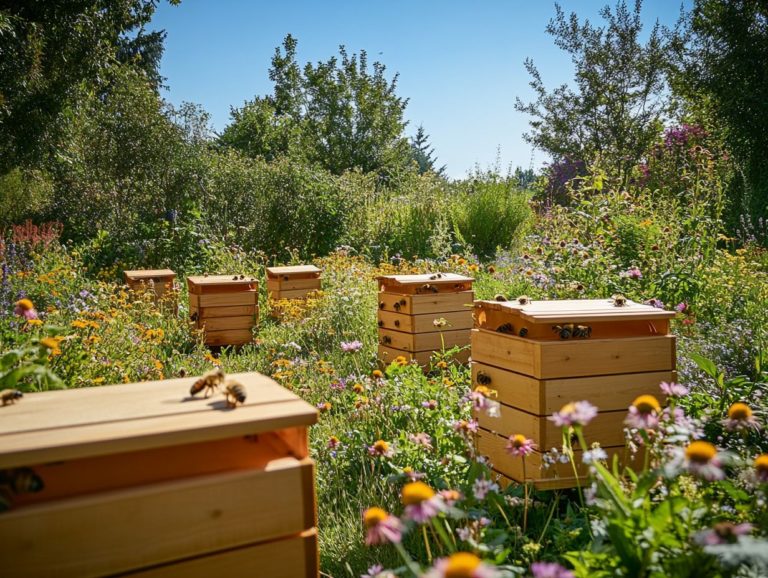Best Beekeeping Equipment for Large Colonies
Beekeeping can be an incredibly rewarding endeavor, particularly when you’re managing large colonies of honey bees.
To ensure the health of your bees and maximize your honey production, selecting the right beekeeping supplies is absolutely essential.
This article delves into the finest beekeeping equipment specifically designed for larger colonies, covering various beekeeping methods, hive types, and indispensable tools.
From Langstroth and Flow Hives to the essential protective gear and harvesting supplies, you will be guided through the available options, including their pros and cons, allowing you to optimize your beekeeping experience. We’ll also touch on the use of Layens frames and horizontal hives.
Contents
- Key Takeaways:
- 1. Langstroth Hives
- 2. Top Bar Hives
- 3. Flow Hives
- 4. Beekeeping Suits
- 5. Smokers
- 6. Hive Tools
- 7. Honey Extractors
- 8. Queen Excluders
- 9. Pollen Traps
- 10. Feeding Supplies
- What Are the Different Types of Beehives and Their Pros and Cons?
- Frequently Asked Questions
- What is the best type of hive for large bee colonies?
- What type of frames should be used for large bee colonies?
- Do I need a feeder for a large bee colony?
- What type of protective gear is best for handling large bee colonies?
- What is the recommended smoker size for large bee colonies?
- Is it necessary to have a queen excluder for large bee colonies?
Key Takeaways:
Understanding these essential beekeeping methods and tools will enhance your beekeeping journey.
1. Langstroth Hives
Langstroth hives are the bedrock of contemporary beekeeping, named after the ingenious Lorenzo Langstroth, who crafted this revolutionary hive system in the 19th century. This style has transformed honey production and colony management, granting you effortless access to the hive’s interior while enhancing the overall health of your colonies. This design also helps in battling varroa mites effectively.
With their removable frames, Langstroth hives deliver versatility and efficiency, making them an essential addition to the beekeeping arsenal of many enthusiasts, including Adam Martin from Bee Kept in Culleoka, Tennessee. Langstroth frames are particularly prized for their ease of use and management.
These frames are thoughtfully designed to allow bees to construct their comb in a uniform manner, ensuring that you can harvest honey with minimal disruption to the colony. Unlike other hive types, the Langstroth system promotes a more consistent and manageable approach to honey extraction, benefiting both you and your bees.
Many practitioners of natural beekeeping value the modularity of Langstroth hives, as this design allows for the integration of foundationless frames and encourages natural comb building. This alignment with nature not only supports sustainable practices but also optimizes honey yields while nurturing the well-being of bee populations.
2. Top Bar Hives
Top Bar Hives offer you a distinctive option in the world of beekeeping, emphasizing natural practices that foster healthier bee populations while ensuring a smooth honey production experience. These hives align well with the principles of natural beekeeping.
These hives feature a series of horizontal bars that allow bees to construct their comb in a more instinctive manner, creating a nurturing environment that stands in contrast to traditional Langstroth hives. Unlike those hives, which depend on stacked boxes and frames, Top Bar Hives make inspections a breeze and minimize stress for the bees. This setup closely resembles their natural habitats, allowing feral bee communities to thrive. Additionally, Layens frames can be adapted for use in these horizontal hives.
With straightforward management and harvesting techniques where honey can be effortlessly collected from each bar without the fuss of complex equipment this approach enhances your beekeeping journey, appealing to both newcomers and seasoned beekeepers who prioritize sustainability. This method is also advocated in various beekeeping schools and classes, like the School of Traditional Skills.
3. Flow Hives
Flow Hives represent a groundbreaking advancement in beekeeping! They elevate your honey harvesting experience while simplifying the process significantly. Books like “Keeping Bees with a Smile” highlight this innovative design.
This innovative approach contrasts sharply with traditional methods that can often feel cumbersome and labor-intensive. With the intuitive mechanics of Flow Hives, you can harvest honey directly from the hive, minimizing disturbance to your bees and fostering a healthier colony.
You ll discover the incredible ease of use these hives provide, allowing you to collect honey swiftly without the burden of heavy equipment or excessive labor. This streamlined harvesting saves you valuable time and helps preserve the natural environment within the hive, ultimately contributing to the well-being of the bee population and ensuring a robust honey yield.
4. Beekeeping Suits
Beekeeping suits are your essential protective gear when working with honey bees! They shield you from stings while enabling effective management of your colonies.
These suits come in various styles, including full-body coverage and vented options that enhance breathability and comfort, especially in warmer climates. Some models have elastic cuffs and hoods with built-in screens, providing added protection without sacrificing visibility. A bee suit is indispensable whether you are managing backyard bees or a large colony.
Wearing proper gear is crucial, as it minimizes the risk of bee stings and boosts your confidence during hive inspections and honey harvesting. When equipped with the right tools, you can focus on ensuring the health of your hives and enjoying a successful harvest of delicious honey.
5. Smokers
A smoker is an essential tool in your beekeeping arsenal! It calms honey bees during inspections and ensures your safety while safeguarding the colony’s health. Using a smoker alongside a hive tool and a bee brush makes hive management smoother.
This remarkable device generates a cool, soothing smoke that masks the alarm pheromones (the bees’ distress signals) they release, allowing for a tranquil hive inspection experience. To produce the best smoke, opt for dry, combustible materials like pine needles, dried leaves, or even newspaper. These materials ignite easily and provide a consistent, reliable stream of smoke.
When managing your hive, puff a gentle cloud of smoke at the entrance and around individual frames before diving into the inspection. This ritual deters aggressive behavior from the bees and triggers a foraging response, as the bees instinctively prepare for any potential disturbances!
6. Hive Tools
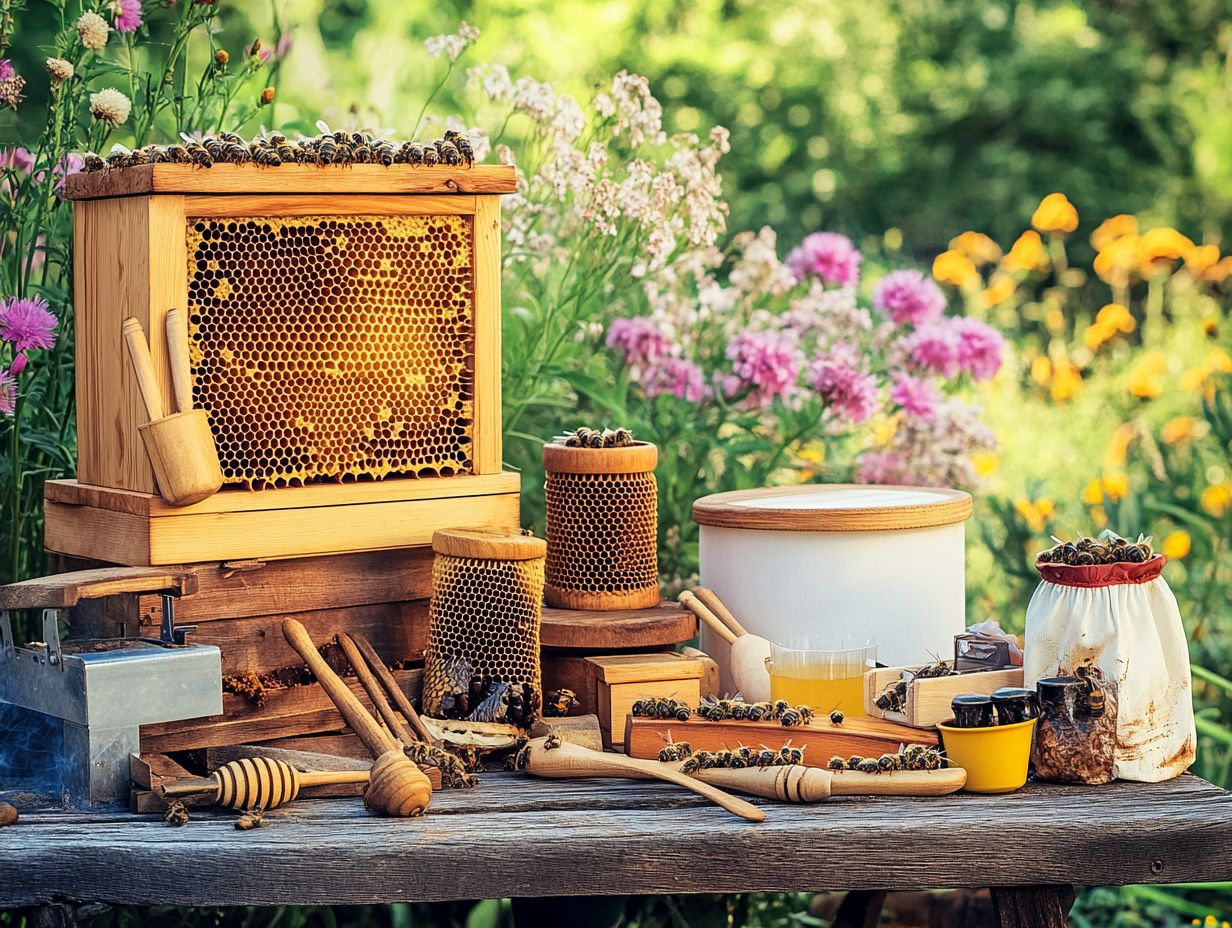
Hive tools are absolutely essential for beekeepers, equipping you with the implements needed for effective bee management.
- Hive lifters help safely elevate heavy hive bodies during inspections, minimizing the risk of injury.
- Scrapers quickly remove excess propolis and wax buildup, giving you better access and visibility into the hive’s interior.
- Bee brushes gently remove bees from frames without causing harm, making your inspection process non-disruptive.
Each of these tools plays a vital role in routine maintenance, helping you keep the hive healthy and effectively monitor your colonies. Effective use of hive tools greatly improves your honeycomb inspection process!
Don t miss out on the chance to enhance your beekeeping experience with these amazing tools!
7. Honey Extractors
Honey extractors are specialized devices designed to improve your honey harvesting experience. They enable you to efficiently extract honey from the comb while preserving the integrity of your hive.
These tools come in various forms, with manual and electric models being the most sought after. Manual extractors often catch the eye of hobbyists due to their affordability and user-friendly design. They require no electricity to operate. In contrast, electric extractors significantly boost your efficiency, particularly in larger operations, by automating the spinning process and speeding up honey extraction.
The extraction process is important in determining the final quality of your honey. By managing the speed and technique of extraction, you can safeguard the honey’s flavor and beneficial properties, ensuring that the end product meets the highest standards. Whether you prefer honey on toast or in peanut butter, the quality of extraction makes a significant difference.
8. Queen Excluders
Queen excluders are essential tools in your hive management strategy. They regulate the queen bee’s movements and ensure the colony’s health, promoting honey production.
These devices are typically constructed from a grid-like material, enabling the worker bees to pass through with ease while keeping the queen confined to the brood chamber. This separation is crucial, as it prevents brood a vital component of the colony’s reproductive cycle from contaminating the honey supers, where the sought-after delicious honey is stored.
This separation allows you to confidently harvest honey without worrying about bee larvae compromising its purity. Utilizing queen excluders supports the overall vitality of your hive and enhances efficient foraging and brood development, benefiting the health and stability of the entire colony.
9. Pollen Traps
Pollen traps are ingenious tools that allow you, as a beekeeper, to collect pollen from your foraging honey bees. They offer valuable resources that contribute to both hive health and honey production.
These clever devices enable bees to exit the hive through a mesh or grate that gently brushes the pollen from their legs. You’ll find various pollen traps on the market, including single entrance and funnel-shaped models, each designed to optimize pollen retrieval while minimizing disruptions to the bees’ natural foraging behaviors.
Using these traps enhances the nutritional intake of your colony since pollen is an essential protein source for bees. It also plays a critical role in maintaining overall colony vitality. When you ensure your bees get enough nutrition, they thrive and produce more honey!
10. Feeding Supplies
Feeding supplies are essential for you as a beekeeper, especially during lean times when resources are scarce. Providing your honey bees with the right nutrition is vital for maintaining optimal colony health and productivity.
Alongside sugar syrup, which acts as a critical energy source, many beekeepers use pollen patties to deliver necessary proteins and fats crucial for brood rearing. Timing is key; in early spring, feeding can stimulate brood production. In autumn, extra support prepares your bees for the winter ahead.
You can use various feeder methods to suit your needs. This flexibility ensures a consistent supply of nutrition, enhancing the resilience and robustness of your hive.
What Are the Different Types of Beehives and Their Pros and Cons?
Understanding the various types of beehives is essential for you as a beekeeper. Each design presents unique advantages and disadvantages that can significantly influence honey production and the health of your colony. Whether you lean towards the traditional Langstroth hive or are intrigued by the modern Flow Hive, each type of beehive comes with its own set of preferences and requirements that can determine your success in beekeeping.
Take, for example, the Langstroth hive, which is celebrated for its efficiency in honey production and ease of harvesting due to frames that can be taken out. This makes inspections a straightforward task! However, be prepared for the fact that they require more maintenance and can be heavier to manage.
On the flip side, Top Bar Hives encourage a more natural beekeeping approach, allowing bees to build their comb freely. This method is often preferred by those who favor minimal interference, but keep in mind it may yield less honey overall.
Then there s the Flow Hive, which offers the remarkable convenience of collecting honey without disturbing your bees, though it does come with a steeper initial price tag. Ultimately, weigh your methods and personal preferences when selecting the right hive to ensure a rewarding and enjoyable beekeeping experience.
How Can a Beekeeper Choose the Right Hive for Their Large Colony?
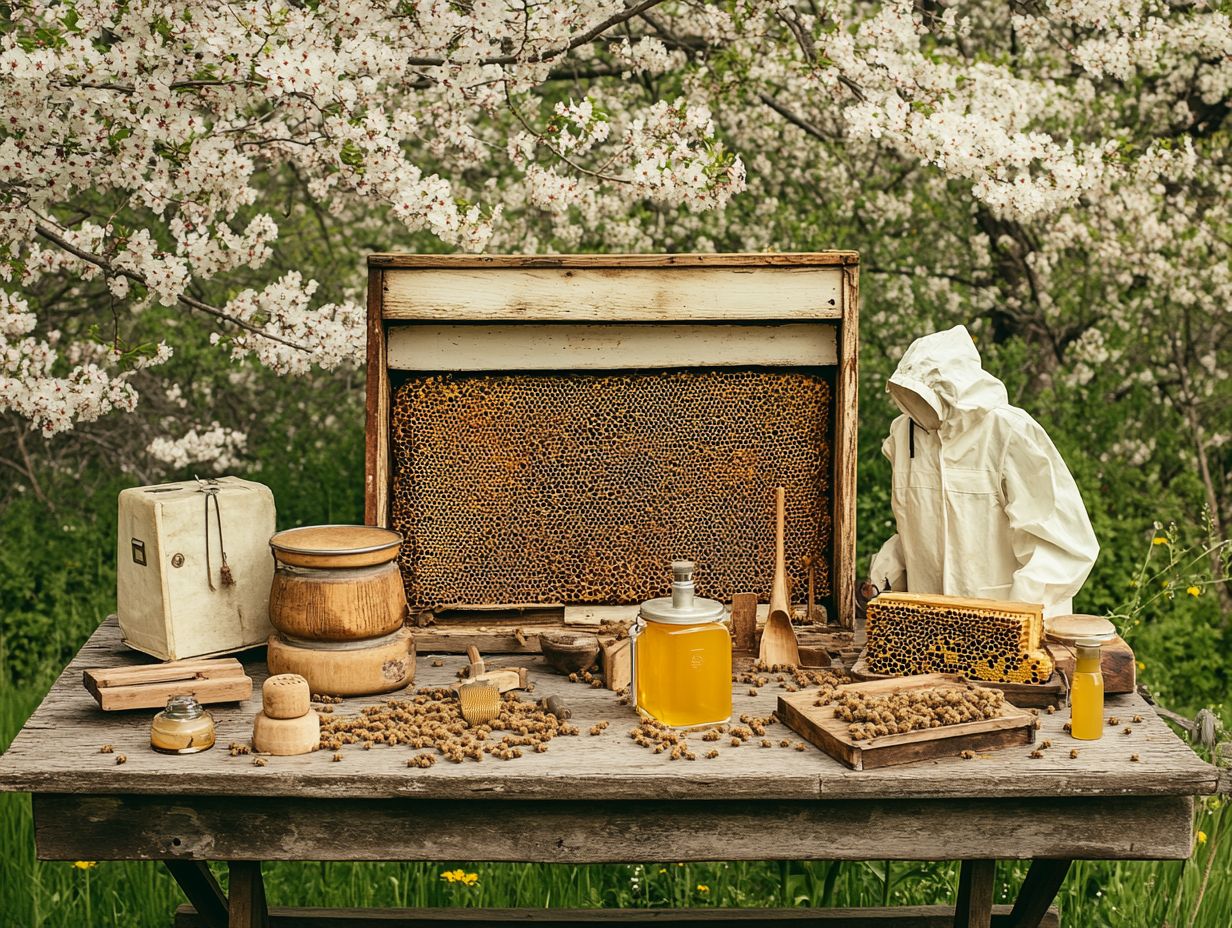
Choosing the right hive for a large colony requires careful consideration of several factors, including the type of bees you re working with, the specific needs of your colony, and the beekeeping methods you prefer much like the insights shared by Adam Martin at Bee Kept.
The space within the hive is essential; a larger colony demands ample room for the bees to thrive, store honey, and raise brood. Consider how easy the hive is to manage hives that simplify inspections and honey collection can significantly enhance your beekeeping experience and efficiency.
Production capabilities can vary widely based on hive design and the beekeeping method you choose, whether it leans towards traditional practices or embraces more contemporary techniques. Don t overlook factors such as ventilation, ease of access, and adaptability to seasonal changes; these elements are vital in ensuring your hive supports robust honey yields and maintains colony health year-round.
What Are the Essential Protective Gear for Beekeepers?
Essential protective gear for you as a beekeeper includes beekeeping suits, gloves, and veils. These components are crafted to ensure your safety and comfort while you manage hives teeming with honey bees.
Beekeeping suits protect your body, gloves keep your hands safe, and veils shield your face. Choose gear that fits well and feels comfortable! These items act as your crucial lines of defense, significantly reducing the risk of those painful stings that can occur during hive inspections and honey extraction.
A well-fitted suit, typically made from breathable fabric, will shield your entire body while allowing for the ease of movement you need. Your gloves should extend long enough to keep those pesky bees from sneaking in, yet still offer the dexterity required for handling your equipment with precision. The veil is a must-have, protecting your face and neck while ensuring you maintain clear visibility.
When selecting your protective gear, consider factors such as the local climate, your personal comfort preferences, and any allergy considerations. This way, you can effectively tailor your safety protocols to suit your unique beekeeping needs.
In summary, understanding the types of beehives, choosing the right hive for your colony, and ensuring you have the proper protective gear are essential steps for successful beekeeping. Are you ready to choose the perfect hive for your bees?
What Are the Must-Have Tools for Beekeeping?
Essential tools for your beekeeping journey include vital items like hive tools, smokers, and bee brushes. These are your ticket to successful hive management!
These tools not only improve your efficiency in maintaining the hives but also contribute to the overall health of your bee colonies. For example, hive tools are essential for opening and inspecting hives, enabling you to evaluate the condition of the colony and take any necessary actions. Smokers serve a crucial role as well; they help calm the bees, reducing their danger during inspections, which is essential for both your safety and the well-being of the bees.
Bee brushes are expertly designed to gently move bees without causing harm, ensuring that your hive inhabitants remain safe while granting you easier access to honey and brood frames. Each of these instruments is significant in cultivating a thriving beekeeping environment.
How Can a Beekeeper Harvest Honey from a Large Colony?
Harvesting honey from a large colony demands careful planning and the right tools think honey extractors and hive tools to ensure the process is not just efficient but also yields high-quality honey.
Before diving in, you should assess the colony’s health, making sure the bees are free from stress or illness. This step is vital; a healthy colony is far more productive and resilient during the harvesting process.
Once you have your equipment ready, it s time to don your protective gear and approach the hives with a gentle touch, minimizing any disturbance. When you remove the honey supers (the box that holds honeycomb), using honey extractors allows you to effectively extract honey without damaging the comb, setting you up for better future harvests.
Always leave some honey for the bees to sustain themselves, especially as cooler seasons approach. Employ techniques that minimize disruptions to their habitat, ensuring both your success and the bees’ health.
What Are the Additional Supplies Needed for Large Colonies?
Managing large colonies necessitates more than just the basic beekeeping toolkit; it calls for a range of additional supplies, such as feeding essentials, pollen traps, and queen excluders, all aimed at ensuring your colonies thrive in health and productivity.
These tools are fundamental to maintaining the vibrant ecosystem within your hive. For example, feeding supplies allow you to offer essential nutrients during lean periods, which is crucial for keeping your colony’s population robust. Pollen traps enable you to collect any excess pollen while ensuring your bees have enough for their dietary needs, fostering strong brood development. Meanwhile, queen excluders keep worker bees from encroaching on the queen’s territory, creating a focused environment that enhances honey production.
When combined, these additional supplies enable you to elevate the overall management and vitality of your expansive colonies, ensuring they flourish under your care.
Frequently Asked Questions
What is the best type of hive for large bee colonies?
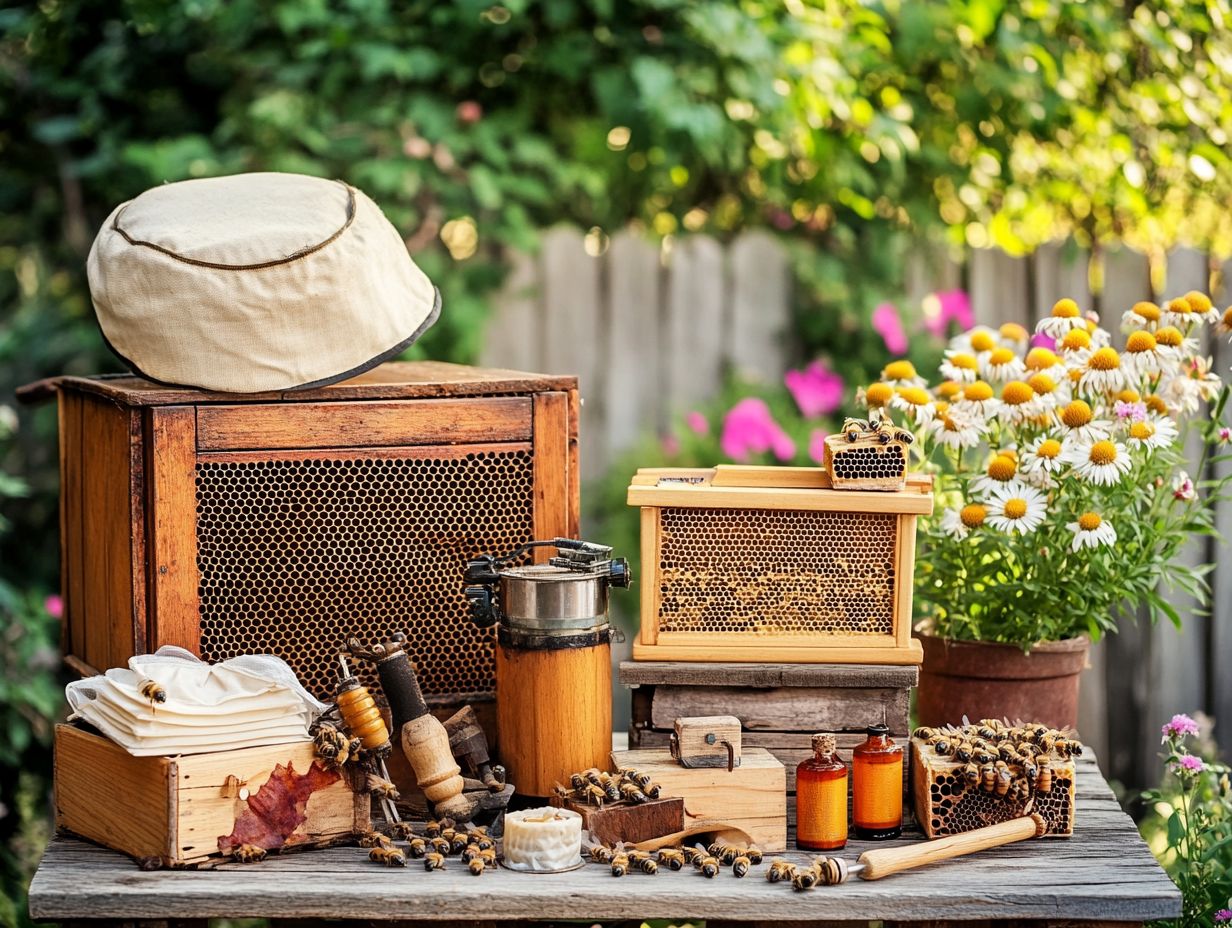
The best type of hive for large bee colonies is the Langstroth hive. This type of hive allows for easy expansion and management of multiple boxes, making it ideal for large colonies.
What type of frames should be used for large bee colonies?
For large bee colonies, it is recommended to use deep frames. These frames provide more space for brood and honey storage, allowing for the colony to thrive and grow.
Do I need a feeder for a large bee colony?
Yes, it is important to have a feeder for a large bee colony. A feeder keeps your bees well-fed, especially when flowers are scarce, ensuring that they have enough food to sustain their growing population during times of low nectar flow.
What type of protective gear is best for handling large bee colonies?
When handling large bee colonies, you need a full beekeeping suit, complete with a veil and gloves. This gear ensures maximum protection from stings while allowing safe and efficient management of the bees.
Don’t forget tools like a hive tool and bee brush to help you manage the bees effectively.
What is the recommended smoker size for large bee colonies?
For large bee colonies, choose a smoker with a larger fuel chamber. This design provides longer smoking times, essential for working with more bees.
Along with the smoker, other must-have tools include a hive tool and queen catcher for effective honey harvesting and colony health.
Is it necessary to have a queen excluder for large bee colonies?
A queen excluder is not necessary for large colonies. In fact, it can limit the queen’s egg-laying ability, which may reduce productivity.
Allow the queen to move freely within the hive. Using Langstroth and Layens frames can help optimize honey production and colony health. Understanding feral bee behavior can also enhance your bee management skills.

